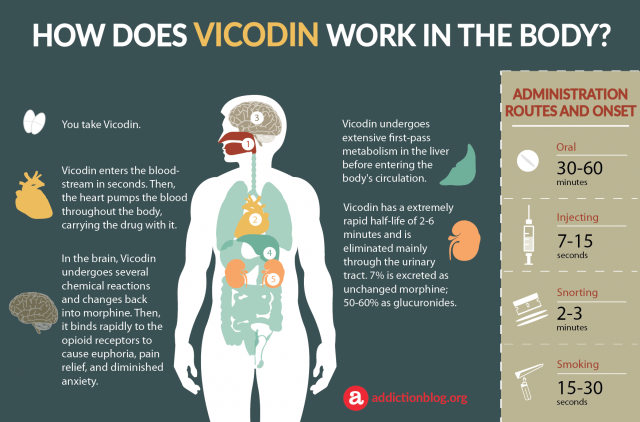Vicodin = Hydrocodone + Acetaminophen
Vicodin is an opioid made by the combination of hydrocodone and acetaminophen. This medicine is used to treat moderate to severe pain. Vicodin works by binding to opiate receptors in the brain, and changes a person’s perception of pain. How does it create this psychoactive effect?
Basically, hydrocodone, the main ingredients in Vicodin, acts on mu receptors and kappa receptors in the central nervous system. The end result of Vicodin is an overall feeling of analgesia and sedation that keeps people out of pain. But Vicodin’s metabolism and route through the body comes with risks.

For example, prescription pain drugs always carry the risk of dependence. This is the case with Vicodin, as well. As a two-drug compound, Vicodin also has a high addiction liability. In fact, the high felt after Vicodin is taken the first few times is one the main reasons why people quickly become hooked to this drug. More in this infographic on Vicodin effects over the entire body, with a section at the end for your questions.
How Does Vicodin Work In The Body?
1. YOU TAKE VICODIN: Vicodin can be used: orally, intranasally, intravenously, or by inhalation. However, chewing, smoking, snorting, or injecting hydrocodone are considered as methods of Vicodin abuse.
2. STOMACH: When you take Vicodin orally, the first important process leading to absorption is dissolution. Hydrocodone dissolves almost immediately in the stomach.
3. NOSE: Snorted Vicodin, delivers the drug in the bloodstream very quickly. When snorted, Vicodin is absorbed by the mucous membrane of the nasal sinus passages. It takes 3-5 minutes before the first effects of high are released. Snorting Vicodin distributes the drug faster to the brain and produces more intense effects.
4. LUNGS: Smoking Vicodin allows small amounts of the drug to enter the bloodstream through the nasal passages and lungs. This leads to a very fast effect on the brain. However, you’re also inhaling the fillers and binders found in Vicodin pills at the same time. These additional chemicals won’t be absorbed by the body. Instead, they cause irritation of the eyes, respiratory system, and lungs, and can eventually lead to illness.
5. HEART: If you take too much Vicodin the heart rate can slow down to the point of death.
6. BRAIN: Vicodin alters the way your brain responses to pain. In the brain hydrocodone, one of the main ingredients in Vicodin binds to “mu” and “kappa” receptors in the central nervous system. The end result is an overall feeling of sedation accompanied by a brief feeling of high.
7. LIVER: Acetaminophen one of the ingredients of Vicodin is a strong analgesic with damaging effects on the liver. If you take too much of Vicodin over a prolonged period of time you are exposing yourself to the risk of liver failure.
8. KIDNEYS: According to the latest FDA reports, kidney failure is present at female users older than 60, who have been using Vicodin for less than a month.
Vicodin Dosage
- Vicodin Tablets 5 mg/300 mg = 1-2 tablets every 4 to 6 hours
- Vicodin ES 7.5 mg/300 mg = 1 tablet every 4 to 6 hours
- Vicodin HP 10 mg/300 mg = 1 tablet every 4 to 6 hours
Vicodin In The Body Questions
In this infographic, we tried to present you more clearly the effects Vicodin has on the body. In case we’ve missed something, you are welcomed to ask us in the comment section below. We value our reader’s opinion and will make sure to provide you with a personal and prompt response.
Reference sources: Vicodin Dosage
How do pills (specifically opiates such as Vicodine or Oxycodone) dissolve in the body?








Related Posts